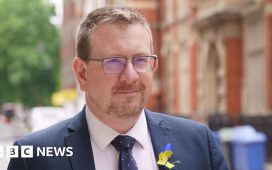In William Wyler’s classic 1953 film Roman Holiday, Audrey Hepburn’s princess character breaks down in tears before briefly escaping the constraints of royal life.
“Please let me die in peace,” she cries, lamenting her stifling schedule of gladhanding, platitudes and plaque unveilings. The Oscar-winning romantic comedy was released in the summer of Elizabeth II’s coronation, as her sister, Margaret, struggled between her sense of duty and her forbidden love for a divorced RAF officer. It perhaps captured something of the reality of royalty’s gilded cage.
Fast forward 72 years and members of Britain’s royal family no longer seem quite so restricted to ribbon cutting and trite conversation. In fact, they appear to be on a mission to change the world, campaigning to end food poverty, eradicate domestic violence, combat homelessness and avoid climate catastrophe, while offering advice on how we can all raise happier children, to improve the future prospects of the kingdom over which they reign.
At the forefront of this drive stand the Prince and Princess of Wales, searching all the time for an overriding goal: impact. Last week Catherine launched a campaign highlighting the 30 key social and emotional skills we all need to live a happier and healthier life, while William met farmers in Scotland to discuss breaking taboos around mental health problems.
William and Catherine insist their passion projects do not politicise their role, although they often communicate with the government about their plans and their endeavours. “We don’t drive in the political lane,” a senior aide to the couple is fond of saying. But, increasingly – and, perhaps inevitably, their work has political impact. It can influence public policy, create demand for public services and affect budgets and resources.
This all risks a potential future clash between the royals and political parties. While William has been careful to avoid politicising his flagship project on ending homelessness, the work naturally raises questions about housing policy, while Catherine’s calls for an improvement in early years provisions inevitably overlaps with questions about education funding and resources.
Craig Prescott, an expert on the constitutional role of the monarchy at Royal Holloway, University of London, says he describes the royal family’s work as “a step or two behind party politics”.
Prescott, who is writing a book on the modern monarchy, says the royals need to tread a fine line and avoid directly putting pressure on politicians to change policies. “I suppose this is why Catherine’s work [on early years] has stopped short of this. It is commissioning research, writing reports, making proposals or suggestions, but stops short of making explicit demands for government to start doing ‘x’, because inevitably that becomes a party political question.”
At times, however, Catherine has been known to express her views. On one visit to a school a few years ago, she asked teachers and pupils: “Do you think every school should have a mental health specialist? William and I do.”
Constraints placed on monarchy in the UK date as far back as the Magna Carta in 1215, and political power has been siphoned from the crown over centuries. James II was the last monarch to claim absolute powers; when he was deposed in the Glorious Revolution of 1688, the supremacy of parliament over the crown was confirmed, ushering in a gradual transfer of real authority from the monarchy to the government. Queen Anne was the last monarch to veto a parliamentary bill, the Scottish Militia Bill, in 1708. The sovereign no longer has a political role, and protocols are followed to protect this neutrality, such as the fact that the current royal family do not vote, although they are technically allowed to do so.
When still heir to the throne, King Charles trod a fine line, avoiding party politics, but often pushing constitutional boundaries. He believed that, as a monarch-in-waiting, he should have the same rights as the Queen to – as the Victorian constitutional writer Walter Bagehot put it – be consulted, to encourage, and to warn ministers, as long as it was done in private.
Charles’s views on many controversial issues are perhaps more widely known than any of his predecessors because of his long record of speaking out as Prince of Wales. He has tempered his speeches since ascending the throne in 2022, but during his mother’s 70-year reign, he was often portrayed as meddling in politics.
Publicly, he cajoled politicians into taking difficult decisions to combat climate change and many other challenges, and, privately, he lobbied ministers to bend to his views on topics ranging from education to architecture and farming practices. Tony Juniper, the longtime green campaigner, once described the king as “possibly the most significant environmental figure of all time”.
Prince William said last year that he wanted to use his royal role differently to previous generations, making it “more about impact philanthropy … and helping people”. The Princess of Wales, meanwhile, has dedicated her “life’s work” to early years campaigning, creating the Royal Foundation Centre for Early Childhood. This month, she wrote a foreword to an expert report which warned that “technoference” is harming children’s communication skills. Last week, Kensington Palace confirmed they would not routinely issue details of Catherine’s outfits for royal engagementsinformation they have been increasingly refusing to give since about 2019, in the hope the media will focus instead on her message and the causes she supports.
Royal philanthropy, and royals’ attempts to improve the lives of their subjects, dates back to at least medieval times. King John made substantial charitable donations across England in the early 13th century. But it was Queen Victoria who really created the modern idea of a monarchy supporting its subjects, becoming patron of 150 organisations, including many charities involved in education and hospitals, and favouring measures to improve the lives of the poor.
Behind the scenes, Victoria often interfered privately to support Conservative politicians over their Liberal rivals. But during her reign, the idea of the monarch staying publicly out of politics became firmly established and royal interference became frowned upon, and has remained so to this day.
This constitutionally delicate, historic arrangement is the fragile backdrop for today’s royal family and the work they choose to do. When asked by the BBC in 2018, while still Prince of Wales, whether he would be a “meddling” king, Charles replied: “I am not that stupid.”
The younger members of the family are, however, determined to have a meaningful impact on the world – as William has said, to “help deliver change”. In 2016, William, Catherine and Harry, who was then still a working royal, launched the Heads Together campaign, encouraging young people to be more open about mental health.
They were open about their ambition to break the stigma around such problems, and to change public attitudes, including through speaking openly about their own struggles. They worked with employers and schools to increase understanding. Some argue they also helped to create a huge demand for professional help that taxpayer-funded services and the NHS could not meet.
In her first public engagement to showcase a skills framework put together by her and William’s Royal Foundation last week, the Princess of Wales eschewed her chauffeur-driven car to ride to the National Portrait Gallery in London in a minibus with a group of reception class children. At the gallery, she tried out a new interactive trail using portraits and other props to explore how faces express feelings with a group of four- and five-year-olds.
The framework outlines 30 key social and emotional skills with the aim of enabling parents, teachers, clinical practitioners and others to understand the latest science, and to help revolutionise the way children are raised. It is part of Catherine’s Shaping Us campaign to give children a better start in the first five years of life.
after newsletter promotion
But it is not just about children, she says, as it is never too late to learn. Aides hope the social and emotional skills will be incorporated into corporate leadership training, team-building exercises, recruitment and professional development for adults across the country.
Kate Silverton, the former BBC newsreader who retrained as a child therapist and works closely with the princess, says: “When children can regulate their emotions, they can focus in school, control impulses, they can take turns, they can engage socially, manage frustration, build healthy relationships, make wise decisions, and avoid self-destructive behaviours. But emotional regulation is not something children are born with. It’s something they must actively learn.”
Catherine, 43, made an addiction charity one of her first patronages after she joined the royal family, and later came to realise after visits to prisons, rehabilitation centres and clinics, that addiction and many of society’s other major problems – family breakdown, crime, homelessness – could often be traced back to emotional trauma in the first five years of childhood.
William, meanwhile, has made ending homelessness one of his goals. Over five years, through six pilot projects in different parts of the UK, he wants to show how bringing the public, private and charity sectors together can help prevent the conditions that lead people to lose their homes or at least make homelessness brief and unrepeated.
He is working with international partners, too, including the mayors of some of the world’s biggest cities, such as Paris, Chicago, São Paulo, and Helsinki, to swap ideas. Lydia Stazen, executive director of the International Mayors Council on Homelessness, believes his convening powers can bring people together to solve the problem. “I think Prince William has the worldwide power to do that,” she says. “We can end homelessness.”
Willam, 42, has also devoted much time to his international awards scheme, the £50m Earthshot Prize, which aims to encourage inventors and entrepreneurs to come up with ideas that will solve the world’s most pressing environmental problems.
The award has helped to promote ideas such as using food packaging made from seaweed instead of plastic in sports stadiums, sustainable electric vehicle tyres that cut air pollution, and environmentally friendly dyes that reduce the use of chemicals in the fashion industry.
In a pooled interview with the British travelling press in Singapore in November 2023, the prince set out his approach to royal duties. “The thing that ties it all together for me is about social leadership,” he said, pointing out his family had often highlighted pressing issues. “I want to go a step further. I want to actually bring change, and I want to bring people to the table who can do the change if I can’t do it.”
As well as his environmental work, Charles created the Prince’s Trust, now the King’s Trust, which has helped more than one million unemployed young people into training and careers since 1976. But whereas he has always balanced numerous philanthropic projects with more traditional royal duties, William and Catherine are trying a new approach of focusing on a small number of campaigns and charities, and doing far fewer engagements each year than the king and some of their other relatives.
Ian Patrick, William’s private secretary, said last summer: “Throughout their work, the Prince and Princess of Wales’s number one priority is to deliver impact. The approach they take to their charitable endeavours is an evolution of how members of the royal family worked in the past.”
The downside is that as the working royal family gets smaller – they are the only royals now undertaking official duties who are under 60 – the monarchy will be seen less often around the country. Fewer charities in Britain, which has one of the world’s biggest voluntary sectors, will enjoy royal patronage, something regarded as the gold standard.
Joe Little, managing editor of Majesty magazine, sees a similar pattern in monarchies across Europe, where the number of taxpayer-funded royals is also getting smaller. He thinks focusing on harder-hitting campaigns instead of old-style ribbon cutting makes sense. “It’s probably a way of giving them a purpose in the early 21st century,” he says. “Things have moved on since the early days of Queen Elizabeth II’s reign in the mid-20th century.”
Republican critics see this as a series of vanity projects designed to make people with no expertise look relevant – as well as something that should be left to elected politicians.
But supporters believe the soft power of the royals, their ability to convene people and the accompanying publicity are important contributions to British life. Silverton defended the princess’s early years work. “It’s totally authentic,” she says. “There are not many people who can bring such a wide range of experts and organisations in a combined initiative to share the science and their learnings in the spirit of public service and for the greater good.”
Prescott thinks there has been a noticeable change in tone. “There’s definitely a sharper edge to things. The state visits to Germany and France have a distinct theme of the environment, perhaps in a way that state visits of the Queen didn’t.
“You also saw this on Friday night, with the dinner at Highgrove,” he says. The king hosted celebrities and the Italian ambassador at his residence last week to celebrate Anglo-Italian ties and culture. “The ‘slow food’ [on the menu] fits in with the king’s views on sustainability and food waste. Of course, none of this is party political, and they have to be careful not to drift into that territory.”














